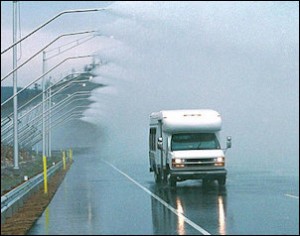by James A. Bacon
Two decades ago the Virginia Tech Transportation Institute (VTTI) had two sponsors, fifteen employees and a dream of becoming a major player in testing new automotive technologies. Sixteen years ago, it opened a literal road to nowhere — a 2.2-mile “smart road” cutting through the hills of Montgomery County that ended in a dead-end loop.
Today, according to John Ramsey writing in Sunday’s Richmond Times-Dispatch, VTTI has 75 sponsors and 475 employees. The institute has helped attract $300 million in research funding to the state. VTTI is by most measures the largest transportation institute in the country.
The McAuliffe administration is hoping to turn that into a magnet for attracting autonomous-related corporate investment to Virginia. The autonomous vehicle initiative is one of the more sophisticated — and promising — economic-development efforts launched by Virginia in recent years. It encompasses more than smart cars. It includes drones, another up-and-coming industry — earlier this year, the first delivery of a humanitarian package by drone took place in Wise County — and autonomous boats.
“They seem like disparate industries, but when you start to think about sensor technologies, aerodynamics, there’s a lot of overlaps in capabilities that will support a land vehicle as well as an air vehicle or marine,” said Secretary of Technology Karen Jackson. She says Virginia has the eighth largest concentration of autonomous-related companies in the country, including those that build sensors and analyze data.
Virginia formed an unmanned systems commission this summer with the following goals:
- Identify the state of all unmanned systems industries in Virginia. This review should look comprehensively at the industry, including the supply chain from pre-competitive research and development through production and operation.
- Identify challenges and needs of the unmanned system industry that may be met with Virginia assets for each domain of unmanned systems (aerial, land, maritime) including but not limited to workforce, research and engineering expertise, testing facilities, manufacturing facilities, and economic development opportunities within the Commonwealth.
- Provide recommendations, develop a value proposition for economic-development marketing purposes, and submit periodic reports on its activities and findings.
Virginia can do much without showering subsidies and tax credits on the industry. For instance, the state has designated 70 miles of highways as “Virginia Automated Corridors” where fully automated cars can be tested on public roads. The state has implemented a simpler process for getting vehicles certified and on the road for testing. The Wallops Island spaceport is building a runway for drone testing, while an initiative is underway in Hampton Roads to develop autonomous boats.
Bacon’s bottom line: Google, Tesla and conventional automobile manufacturers are, and will continue to be, dominant players in developing and manufacturing autonomous cars, but there’s no reason that Virginia can’t get a share of the spoils from this emerging industry. The technology is new and in flux. The sector is big and sprawling, and hasn’t established a geographically centered clustered yet.
From a 10,000-foot perspective, Virginia seems to be going about this the right way, combining Virginia Tech’s R&D strengths with targeted economic-development marketing and the Virginia Department of Transportation’s (VDOT) opening up of state roads for real-world testing.
The only piece not mentioned in Ramsey’s story is evidence of any study of the state’s liability laws. If anything holds back the development of autonomous vehicles in Virginia, and other states, it will be a hostile tort climate. Given the fact that 90% of all traffic accidents occur as the result of human error, autonomous vehicles will likely make the roads far safer. But if accidents occur involving autonomous vehicles, as inevitably they will, it will be virtually impossible in some instances to disprove plaintiff claims that the fault resided somewhere in the millions of line of code. (See the “Demon in the Machine.”) Sorting out liability issues in a way that both promotes the public welfare and compensates accident victims from genuine wrongs would give Virginia a huge competitive advantage.
One thing Virginia is indisputably good at is producing lawyers. We ought to bring our best legal minds together — I nominate Chris Spencer, one of the top automobile liability attorneys in the country — to craft model tort legislation. If we can add that to our list of assets, we truly can make Virginia a national leader in unmanned vehicles.



